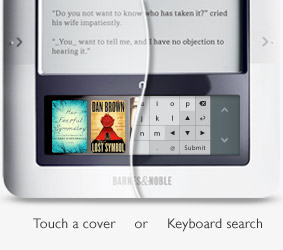Converting a book reader to a nook reader
Steve Outing | Jan 10, 2010
My wife, Suzanne, has long had to put up with a husband who’s a new-gadget hound. I’m an early adopter but not a super-early adopter. We’ve had a TiVo DVR for years, but I wasn’t among the very first to purchase one. I waited for the iPhone 3G to come out before catching iPhone fever. (Suzanne has one, too.) She tends to tag along, patient with me when I enthuse about some new gizmo. (Like the Roku box I bought as a family Christmas present. No one else in the family had a clue what it was supposed to do.) Eventually Suzanne sees the wisdom of (most) of my new-gadget purchases.

Barnes & Noble's nook e-book reader
In observing her use of the nook in the first couple weeks, I’ve come to predict that the nook (and the Kindle) will not win over huge chunks of the population. While the devices and their E Ink screens make for a wonderful reading experience (my opinion) and are easy on the eyes in a way that reading lengthy prose on a backlit screen is not, they’re still not quite ready for truly mass-market success.
Perhaps Apple will debut the Kindle- and nook-killer later this month. I’m looking forward to seeing what Steve Jobs is hiding from public view.
Anyway, here’s a quick run-down of Suzanne’s first couple weeks with the nook (as observed by me):
- Initial enthusiasm and “that’s so cool” reaction
- Love for some features like tap on a word to get a definition; add notes to sections as you’re reading; highlighting key passages; etc.
- Some disillusionment: “You mean you can’t read it in bed in the dark? You have to have a light on to see the screen?”
- After she played around with it a bit, the nook went in a bedside drawer, not seeing much use
The final point needs some explanation, because it’s not a rejection of the product. Rather, Suzanne has a pile of books on her reading and book-club list, waiting to be picked up. What’s the point of spending an extra $10 for a nook e-version? Books on nook will have to come later, when the paid-for or from-the-library printed versions have been read.
One book on her to-read list is already in hand in digital form, purchased from Amazon for reading on her iPhone. She was disappointed that that purchase couldn’t simply be ported to her nook.
More alarming (to me) was an e-mail receipt showing up in my inbox from Amazon.com, showing that Suzanne had ordered a printed book after receiving the nook. It turns out that it was a cookbook, with color photos, and that didn’t seem like the right kind of book to order in digital form for an e-reader than only displays black, grays, and white.
Magazines and newspapers? Nope, she told me; won’t use the nook for that, especially since the monthly subscription prices per publication are ridiculously high, and she can read most of them on the web for free.
I’ll continue to spy on my wife’s nook usage (or lack thereof), and I suspect that I’ll see her make the transition to digital books read on the nook, in time.
Suzanne was, I guessed, the ideal nook/Kindle convert: librarian, book lover, and not a techno-phobe. Alas, it was not love at first sight.
This makes me think that we’re not quite there yet. What will become a mass-market hit, I believe, will be a thin tablet computer that does everything an iPhone with a big color screen could do (i.e., a full-fledged wirelessly connected computer), and is an outstanding form factor for reading books.
The trick will be getting the price down to a few hundred dollars, and that may take a while.
The ultimate tablet, I think, would be that large, thin iPhone/iTouch device with a stunning color, backlit touch-screen. And it would have a switch to turn the screen into a paper-like E Ink experience with no backlight, for comfortable book and other long-form reading.
Alas, unless Mr. Jobs has some magic up his sleeve, that may be a pipe dream.
Strike those last two paragraphs in my original of this blog item. It seems that a single screen that can be both back-lit color and E-Ink quality reflective display for reading in light is possible; indeed, it exists. Pixel Qi showed off such technology at the Consumer Electronics Show last week. Here’s a Gizmodo report on this amazing development.
And then there’s Mirasol displays, which could be the technology that moves media tablets where they need to go. Exciting stuff!
(Boulder-based publishing industry analyst and consultant Steve Outing originally wrote this article for his blog, steveouting.com.)

